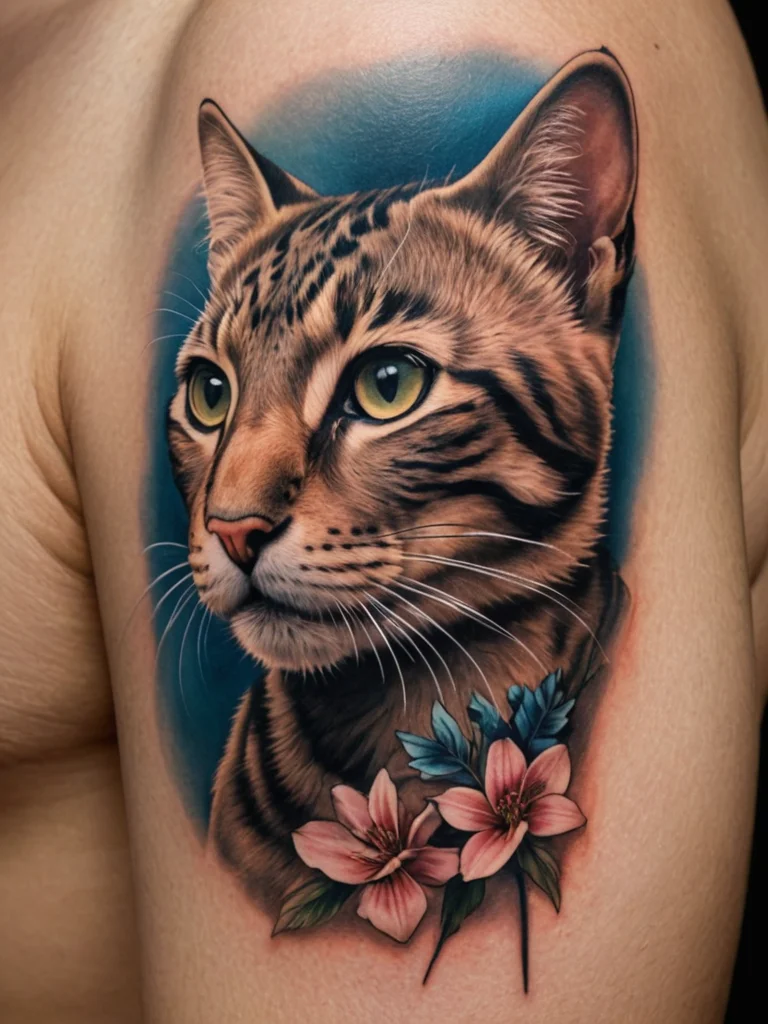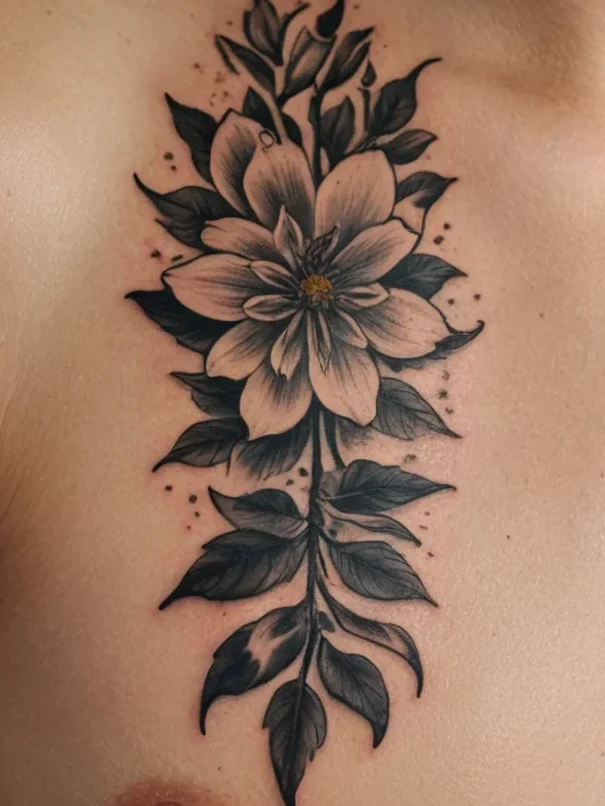Getting a new tattoo is an exciting experience, a permanent piece of art etched onto your skin. However, the journey doesn’t end when you leave the tattoo studio. Proper aftercare is paramount, and moisturizing plays a starring role in ensuring your tattoo heals beautifully and maintains its vibrancy for years to come. Neglecting this crucial step can lead to a host of problems, from faded ink and prolonged healing to infection and scarring. Therefore, understanding when and how to moisturize your new tattoo is an investment in its long-term health and aesthetic appeal. Think of your new tattoo as a precious flower. It needs the right nurturing to bloom in full color.
The golden window: Determining the optimal time to start moisturizing after getting inked (and why timing matters)

The timing of your first moisturizing session is crucial. Tattoo artists typically recommend waiting at least 24 hours after getting your tattoo before applying any moisturizer. This waiting period allows the initial wound to begin to close and prevents trapping bacteria under a layer of cream. Think of it like this: your skin has just been through a trauma. It needs to breathe and begin the natural healing process before you introduce any external products. Applying moisturizer too early can create a breeding ground for bacteria, increasing the risk of infection. On the other hand, waiting too long can lead to excessive dryness and scabbing, hindering the healing process and potentially affecting the tattoo’s appearance. After the initial 24 hours, gently wash the tattooed area with a mild, fragrance-free soap and pat it dry with a clean paper towel. Once the area is completely dry, you’re ready to apply a thin layer of moisturizer.
Step-by-step guide: How to properly moisturize your new tattoo for best results

Moisturizing a new tattoo isn’t just about slapping on some lotion. It’s a delicate process that requires care and attention to detail. Here’s a step-by-step guide to ensure you’re doing it right:
- Wash your hands thoroughly: This is non-negotiable. Before touching your new tattoo, ensure your hands are clean to prevent introducing bacteria to the healing wound. Use antibacterial soap and warm water, scrubbing for at least 20 seconds. Think of it like preparing for surgery – cleanliness is paramount.
- Gently clean the tattoo: Use a mild, fragrance-free, antibacterial soap and lukewarm water to gently cleanse the tattooed area. Avoid using harsh scrubs, loofahs, or anything that could irritate the skin. Use your fingertips to gently lather the soap and rinse thoroughly with water. Imagine you are washing a delicate piece of art – be gentle and deliberate.
- Pat dry with a clean paper towel: Do not rub the tattoo with a towel, as this can irritate the skin and disrupt the healing process. Instead, gently pat the area dry with a clean, unused paper towel. Paper towels are preferable to cloth towels, which can harbor bacteria. Think of it as blotting a watercolor painting – you want to remove the excess water without disturbing the delicate surface.
- Apply a thin layer of moisturizer: Using a small amount of moisturizer, gently apply a thin layer to the tattooed area. Avoid applying too much, as this can trap moisture and prevent the skin from breathing. The goal is to hydrate the skin, not suffocate it. A good rule of thumb is to use just enough moisturizer to make the tattoo look slightly shiny, but not greasy. Imagine you are applying a light coating of oil to a wooden surface – you want to enhance the natural beauty without making it slick.
- Gently massage the moisturizer into the skin: Use gentle, circular motions to massage the moisturizer into the skin. This will help the moisturizer absorb properly and promote blood circulation, which can aid in healing. Be careful not to apply too much pressure, as this can irritate the tattoo. Imagine you are giving your skin a gentle massage – be soothing and deliberate.
- Repeat the process 2-3 times a day: Moisturize your tattoo 2-3 times a day, or whenever it feels dry. The frequency will depend on your skin type and the environment you live in. If you live in a dry climate, you may need to moisturize more often. If you have oily skin, you may need to moisturize less often. Pay attention to your skin and adjust the frequency accordingly. Think of it like watering a plant – you need to adjust the watering schedule based on the plant’s needs and the environmental conditions.
It’s important to note that over-moisturizing can be just as harmful as under-moisturizing. Too much moisturizer can create a breeding ground for bacteria, leading to infection. Look for signs of over-moisturization, such as redness, bumps, or a slimy feeling. If you experience any of these symptoms, reduce the frequency of moisturizing and consult with your tattoo artist or a healthcare professional.
Choosing the right moisturizer: Ingredients to look for (and what to avoid to prevent infections and allergic reactions)
Selecting the right moisturizer is paramount for a healthy and vibrant tattoo. Not all moisturizers are created equal, and some can even hinder the healing process or cause adverse reactions. You’re essentially choosing a healing balm, so select wisely.
- Ingredients to look for:
When choosing a moisturizer, prioritize products with the following beneficial ingredients:
- Emollients: These ingredients help to soften and smooth the skin by filling in the spaces between skin cells. Common emollients include shea butter, cocoa butter, and coconut oil. They create a protective barrier that prevents moisture loss and keeps the skin supple. Think of emollients as the mortar that holds the bricks of your skin together, creating a smooth and solid surface.
- Humectants: These ingredients attract moisture from the air and draw it into the skin. Common humectants include hyaluronic acid, glycerin, and honey. They help to keep the skin hydrated and prevent dryness. Think of humectants as tiny sponges that soak up moisture from the air and deliver it to your skin cells.
- Occlusives: These ingredients create a protective barrier on the surface of the skin that prevents moisture from escaping. Common occlusives include beeswax, petroleum jelly, and lanolin. They are particularly effective in dry environments where moisture loss is a concern. Think of occlusives as a waterproof shield that locks in moisture and protects your skin from the elements.
- Panthenol (Vitamin B5): Known for its soothing and healing properties, panthenol helps to reduce inflammation, promote cell regeneration, and keep the skin moisturized. It’s a versatile ingredient that’s beneficial for all skin types, especially sensitive skin. Think of panthenol as a soothing balm that calms irritated skin and promotes healing.
- Vitamin E: An antioxidant that helps to protect the skin from damage caused by free radicals. It also helps to improve skin elasticity and reduce the appearance of scars. Think of vitamin E as a shield against environmental damage, protecting your tattoo from fading and premature aging.
- Ingredients to avoid:
Certain ingredients can irritate the skin, cause allergic reactions, or even hinder the healing process. Avoid moisturizers containing the following:
- Fragrances: Fragrances are a common cause of allergic reactions and skin irritation. Choose fragrance-free moisturizers to minimize the risk of adverse reactions. The chemicals used to create fragrances can be harsh on sensitive skin and can disrupt the healing process.
- Dyes: Like fragrances, dyes can also irritate the skin and cause allergic reactions. Opt for moisturizers that are free of artificial colors. Dyes serve no beneficial purpose and only increase the risk of irritation.
- Alcohol: Alcohol can dry out the skin and delay the healing process. Avoid moisturizers that contain alcohol, especially in the early stages of healing. Alcohol strips the skin of its natural oils, leaving it dry and vulnerable to infection.
- Petroleum-based products (in excess): While petroleum jelly can be an effective occlusive, using too much can clog pores and prevent the skin from breathing. Use petroleum-based products sparingly and only if necessary. Look for alternatives like beeswax or shea butter, which are more breathable and less likely to clog pores. A thin layer is often sufficient.
- Lanolin (for some): While lanolin is a natural emollient derived from sheep’s wool, some individuals may be allergic to it. If you have a known wool allergy, avoid moisturizers containing lanolin. Even if you don’t have a known allergy, it’s always a good idea to test a small amount of the moisturizer on a discreet area of skin before applying it to your tattoo.
- Harsh chemicals: Ingredients like parabens, sulfates, and phthalates can be irritating and potentially harmful. Choose moisturizers that are free of these chemicals. These chemicals are often used as preservatives or emulsifiers, but they can disrupt the skin’s natural balance and cause irritation.
A Note on Natural vs. Synthetic:
While natural ingredients are often perceived as being gentler and safer, it’s important to remember that even natural ingredients can cause allergic reactions. Always test a new moisturizer on a small area of skin before applying it to your tattoo, regardless of whether it’s natural or synthetic. Pay attention to how your skin reacts and discontinue use if you experience any irritation.
Consulting Your Tattoo Artist:
Ultimately, the best moisturizer for your new tattoo will depend on your skin type and your tattoo artist’s recommendations. Don’t hesitate to ask your tattoo artist for advice on which products to use. They have experience with a wide range of skin types and tattoos and can provide personalized recommendations based on your individual needs. They may even have specific brands or products that they recommend based on their experience. Many tattoo artists sell aftercare products in their studios, which can be a convenient way to get the right moisturizer for your tattoo.
Troubleshooting: Common problems with tattoo moisturizing (dryness, irritation, acne) and how to fix them

Even with the best intentions, you might encounter some common problems during the tattoo healing process related to moisturizing. Recognizing these issues and knowing how to address them can prevent complications and ensure a smooth healing journey.
- Dryness:
Dryness is one of the most common issues encountered during tattoo aftercare. It can manifest as flaky skin, itchiness, and a tight feeling in the tattooed area. This can lead to scratching, which can damage the tattoo and increase the risk of infection. Think of your skin as parchment. If it gets too dry, it becomes brittle and prone to cracking.
- Causes:
Several factors can contribute to dryness, including:
- Insufficient moisturizing: Not moisturizing frequently enough or using a moisturizer that’s not hydrating enough.
- Harsh soaps: Using soaps that strip the skin of its natural oils.
- Environmental factors: Exposure to dry air, wind, or sun.
- Dehydration: Not drinking enough water.
- Solutions:
- Increase moisturizing frequency: Moisturize your tattoo more often, up to 4-5 times a day, if needed.
- Switch to a more hydrating moisturizer: Choose a moisturizer with a higher concentration of humectants and emollients.
- Use a humidifier: If you live in a dry climate, use a humidifier to add moisture to the air.
- Drink plenty of water: Stay hydrated to keep your skin moisturized from the inside out.
- Avoid harsh soaps: Use a mild, fragrance-free soap specifically designed for sensitive skin.
- Irritation:
Irritation can manifest as redness, swelling, itching, and a burning sensation in the tattooed area. It’s important to distinguish irritation from infection, as the treatments are different. Think of irritation as an allergic reaction – your skin is reacting negatively to something.
- Causes:
- Allergic reaction to moisturizer: Sensitivity to ingredients in the moisturizer, such as fragrances, dyes, or preservatives.
- Over-moisturizing: Applying too much moisturizer, which can trap moisture and irritate the skin.
- Rubbing or scratching: Irritating the skin by rubbing it with a towel or scratching it.
- Exposure to irritants: Contact with harsh chemicals, detergents, or allergens.
- Solutions:
- Discontinue use of the current moisturizer: If you suspect an allergic reaction, stop using the moisturizer immediately and switch to a hypoallergenic, fragrance-free alternative.
- Reduce moisturizing frequency: If you’re over-moisturizing, reduce the frequency of application to 1-2 times a day.
- Avoid rubbing or scratching: Resist the urge to rub or scratch the tattoo. Gently pat the area dry after washing and avoid wearing tight clothing that could irritate the skin.
- Apply a cold compress: A cold compress can help to reduce inflammation and relieve itching.
- Consult a healthcare professional: If the irritation is severe or doesn’t improve after a few days, consult a doctor or dermatologist.
- Acne:
Small, pimple-like bumps may appear around the tattooed area, especially if you have oily skin or are using a moisturizer that’s too heavy. This is often caused by clogged pores. Think of it as your skin trying to breathe, but being suffocated by the moisturizer.
- Causes:
- Over-moisturizing: Applying too much moisturizer, which can clog pores.
- Using a comedogenic moisturizer: Choosing a moisturizer that contains ingredients that are known to clog pores.
- Excessive sweating: Sweat can trap dirt and oil in the pores, leading to breakouts.
- Tight clothing: Wearing tight clothing that rubs against the tattoo can irritate the skin and clog pores.
- Solutions:
- Reduce moisturizing frequency: Moisturize your tattoo less often to allow the skin to breathe.
- Switch to a non-comedogenic moisturizer: Choose a moisturizer that’s specifically formulated not to clog pores. Look for labels that say “non-comedogenic” or “oil-free.”
- Keep the area clean and dry: Wash the tattoo regularly with a mild, antibacterial soap and pat it dry thoroughly.
- Wear loose clothing: Avoid wearing tight clothing that could irritate the skin or trap sweat.
- Avoid picking or squeezing: Resist the urge to pick or squeeze the pimples, as this can lead to infection and scarring.
- Consult a dermatologist: If the acne is severe or persistent, consult a dermatologist.
When to Seek Professional Help:
While many minor issues can be resolved with simple home remedies, it’s crucial to recognize the signs of a more serious problem. Seek professional help from a doctor or dermatologist if you experience any of the following:
- Signs of infection: Excessive redness, swelling, pain, pus, or fever.
- Severe allergic reaction: Difficulty breathing, hives, or swelling of the face or throat.
- Persistent irritation or acne: If the irritation or acne doesn’t improve after a few days of home treatment.
- Changes in the tattoo’s appearance: Fading, distortion, or raised areas.
By paying close attention to your skin and addressing any problems promptly, you can ensure that your new tattoo heals beautifully and remains a vibrant piece of art for years to come. Remember, proper aftercare is an investment in your tattoo’s long-term health and appearance.